| Srl | Item |
| 1 |
ID:
132260
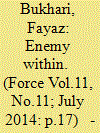

|
|
|
|
|
| Publication |
2014.
|
| Summary/Abstract |
This year the Indian Army achieved a major success by killing 41 militants including 11 top commanders of Lashkar-e-Toiba (LeT), Jaish-e-Mohammad (JeM) and Hizbul Mujahideen (HM) and arrested 23 of them in joint operations with the police.
The figures reveal that this is more than the number of militants neutralised last year, but over the years killing of militants is not making much of a difference as new recruits replace them.
Lieutenant General Subrata Saha, who took over as the General Officer Commanding (GOC) of Army's strategic Chinar Corps or 15 Corps, responsible for tackling militancy in Kashmir besides guarding the Line of Control (LC), has a bigger challenge ahead. For him, killing the militancy is a challenge and not counting the dead.
As per the figures given by the Jammu and Kashmir Police, there are 130 active militants in Kashmir valley and if the rate at which they were eliminated this year continues, not a single militant will be left by next year.
Says a senior army officer: "That is not the case, as per our records at least 16 Kashmiri youth, mostly educated, joined militancy this year. The numbers could be more than our records. And on an average two-three youth get lured into militancy during the funeral of a militant commander."
|
|
|
|
|
|
|
|
|
|
|
|
|
|
|
|
| 2 |
ID:
132264
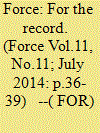

|
|
|
|
|
| Publication |
2014.
|
| Summary/Abstract |
Unlike the four earlier editions of international trade media briefings (TMB) this time around the head of airbus defence and space (military aircraft), Doningo - Urea Raso appeared a bit subdued initially. But it was just play of light in the fading hours of the day at La-Hacienda, a 17th century Andalusian fort of the outskirt of Seville.
|
|
|
|
|
|
|
|
|
|
|
|
|
|
|
|
| 3 |
ID:
132265
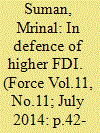

|
|
|
|
|
| Publication |
2014.
|
| Summary/Abstract |
The Indian policy regime is infamous for subordinating national concerns to the interests of some self-seeking pressure groups. Worse, a number of self-proclaimed experts readily join hands with egocentric lobbies to spread disinformation. Invariably, truth becomes the first casualty. False examples, taken out of context, are cited in support of their flawed contentions. The case of Foreign Direct Investment (FDI) in defence is symptomatic of the detrimental malaise that afflicts the Indian polity and the intelligentsia.
|
|
|
|
|
|
|
|
|
|
|
|
|
|
|
|
| 4 |
ID:
132262
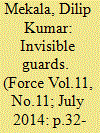

|
|
|
|
|
| Publication |
2014.
|
| Summary/Abstract |
A wide variety of state-of-the-art UGS systems are now available in the market
The use of unattended ground sensors (UGS) for border security applications has gained momentum in recent times across the world. For India, where the border guarding forces face significantly large number of challenges manning the open and porous borders, the UGS could provide a perfect solution. It is no surprise that Indian armed forces are now in the process of procuring these advanced sensors.
The ministry of home affairs (MHA) had issued an expression of interest (EoI) in 2013 to procure UGS systems for Border Security Force (BSF). This initiative from the MHA came after the reports of a 400 metre long tunnel was found in Jammu and Kashmir close to the international border. "Hand-held control receiver and variety of sensors like, passive infrared sensor to detect movement of object in a narrow field of view, magnetic sensors to monitor movement of metallic objects such as weapons or vehicles and seismic sensors to identify ground vibration caused by vehicles or pedestrians (should be encompassed in the device)," stated the qualitative requirements floated by the Paramilitary.
|
|
|
|
|
|
|
|
|
|
|
|
|
|
|
|
| 5 |
ID:
132267
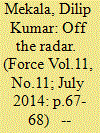

|
|
|
|
|
| Publication |
2014.
|
| Summary/Abstract |
The government should speed up its project of integrating India's coastline into one radar network The horrific terror attack on Mumbai on 26 November 2008 exposed the vulnerability of the Indian continent via the sea route. Immediately after, the ministry of home affairs (MHA) planned to integrate the entire coastline into one radar network which can seamlessly monitor movements in the sea. The government entrusted Bharat Electronics Limited (BEL) with the responsibility of establishing a chain of 46 static radar sensors along the coastline in Phase-I of the project. Out of these, 36 were planned to be implemented on the mainland while the remaining 10 were to be set up on the islands. As of August 2013, BEL's project was able to activate only 34 radar stations on the mainland.
|
|
|
|
|
|
|
|
|
|
|
|
|
|
|
|
| 6 |
ID:
132266
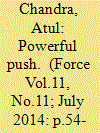

|
|
|
|
|
| Publication |
2014.
|
| Summary/Abstract |
Aero engines continue to push the boundaries of technology in the quest to cater for increased performance and substantially improved fuel efficiency, In February this year Rolls-Royce (RR) provided details of two advanced aero engines which could be ready in just a decade. According to Colin Smith, Rolls-Royce director - engineering and technology "These new designs are the result of implementing our ongoing technology programmes. They are designed to deliver what our airframe and airline customers tell us they need: even better fuel efficiency, reliability and environmental performance."
|
|
|
|
|
|
|
|
|
|
|
|
|
|
|
|
| 7 |
ID:
132263
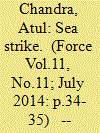

|
|
|
|
|
| Publication |
2014.
|
| Summary/Abstract |
Plans are afoot for the Indian Navy to induct a variety of potent anti-ship weapons in this decade Over the course of this decade, the Indian Navy would have inducted a range of new generation anti-ship missiles which will offer substantially greater engagement ranges, improved warheads and appreciably greater target acquisition and detection capability.
Modern warships being produced at Indian shipyards today have far greater target detection ranges than ever before. This fact, coupled with their shipborne anti-ship missiles and those carried on board the MiG-29K and Boeing P-8I, would mean that the adversary can expect to be hit hard and at a considerable distance away from causing harm to Indian naval ships. Apart from this, the Scorpene submarine with MBDA Exocet AM39 missiles will present a potent threat to sea-going assets of the enemy.
The navy had already set into motion the process to acquire a number of medium range anti-ship missiles to be installed aboard its current fleet of ships and future types. The crown jewel amongst the navy's anti-ship missiles is the supersonic (Mach 3 capable) Brahmos cruise missile. Equipping a number of warships, the Brahmos is the prime strike weapon on the Project 1135.6 guided missile frigates (Talwar Class). The supersonic cruise missile was successfully flight tested from INS Kolkata, the lead ship of the indigenously developed Project 15 A Class Destroyers, the follow-on ships will be INS Kochi and INS Chennai respectively. The 7,000 tonne warship can carry 16 Brahmos missiles under its deck which are fired through a Universal Vertical Launch Module (ULVM).
|
|
|
|
|
|
|
|
|
|
|
|
|
|
|
|
| 8 |
ID:
132257
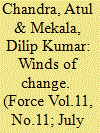

|
|
|
|
|
| Publication |
2014.
|
| Summary/Abstract |
Ensuring that delayed crucial aviation projects are delivered fast should be the new government's priority
Hope is riding high on the new Narendra Modi government. Little over a month after assuming the high office, India's Prime Minister has managed to boost the confidence of the Indian military forces. While symbolic gestures like spending a day aboard INS Vikramaditya helped to bring in motivation to the Indian Navy, which was plagued by series of accidents in the last few months; it is his policy decisions like opening up the defence industry to the private sector that has attracted foreign investors' confidence.
|
|
|
|
|
|
|
|
|
|
|
|
|
|
|
|
| 9 |
ID:
132261
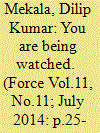

|
|
|
|
|
| Publication |
2014.
|
| Summary/Abstract |
Information is power in modern day warfare. As military forces are constantly increasing their versatility and agility with the new and improved weapon systems, they also understand the importance to shore up their intelligence through surveillance and reconnaissance missions, and review their operational readiness. For a military force to have tactical advantage in a combat situation, it is absolutely important to gather as much intelligence as possible about the opponent.
|
|
|
|
|
|
|
|
|
|
|
|
|
|
|
|